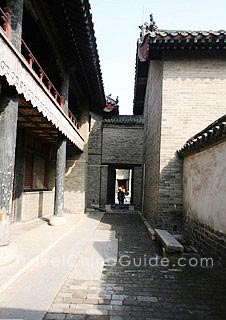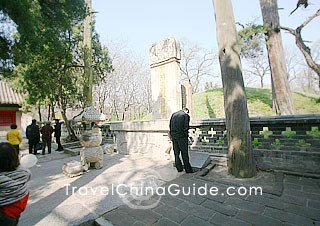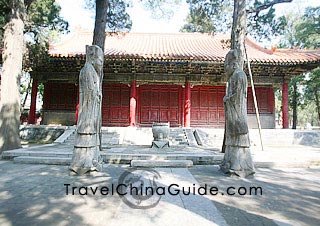Confucius Family Mansion & Cemetery
Confucius Family Mansion (Kong Fu)
 |
| Photos of Confucius Family Mansion |
Covering 39 acres, the mansion grounds house 463 buildings such as halls, pavilions, and towers that are divided into three parts. The Eastern part is the family temple, the Western institute and the Central main buildings. The Central part is then divided into two sections with the front being the office and the family residence behind. The garden is located at the back of the residence.
Though less splendid than the Forbidden City, the Mansion boasts luxury furnishings, exquisite decorations, and precious cultural relics. These relics, some given by emperors, some presented by high ranking officials and celebrities, and some purchased at a high price, are the most valuable resource for research on ancient Chinese history and culture.
This family mansion is the largest of its kind in Chinese history. In 1994, the Mansion, the Cemetery and the Temple were listed as World Cultural Heritage buildings.
Confucius Cemetery (Kong Lin)
 |
The sacred way that leads up to the cemetery is 1,266 meters (4,153 feet) and is lined with verdant pines and cedars. At the end of the road stands a wooden memorial archway - called the Most Sacred Cemetery (Zhi Sheng Lin), and is the gate to the Cemetery of Confucius.
The evolution of the Cemetery reflects the role of Confucianism through history. During his eventful life, the sage drifted from one place to another,
 trying to persuade the authorities to adopt his philosophy, but with little success. It was during later dynasties that Confucianism gained popularity among the authorities. Therefore, before his tomb, a tombstone of the Master and the Most Sacred Wenxuan King was set up in 1443. To the east lies the tomb of his son, Kong Li, while to the south is the tomb of Kong Ji, his grandson. This configuration is called 'holding the son and hugging the grandson'; considered an ideal family pattern in China.
trying to persuade the authorities to adopt his philosophy, but with little success. It was during later dynasties that Confucianism gained popularity among the authorities. Therefore, before his tomb, a tombstone of the Master and the Most Sacred Wenxuan King was set up in 1443. To the east lies the tomb of his son, Kong Li, while to the south is the tomb of Kong Ji, his grandson. This configuration is called 'holding the son and hugging the grandson'; considered an ideal family pattern in China.Beside the tombs stand steles inscribed with handwritings of the notable people of the times, and vibrant stone sculptures. The Cemetery is renowned for its natural botanical areas, largely owing to more than 1,000 mature trees. It is said that after the sage's death, disciples planted rare trees from all over China. Some of the trees are so rare that their proper names are yet unknown.
When you walk into the Cemetery and fully enjoy the treasures here, you will certainly be impressed by the role of the sage in Chinese culture.
| Admission Fee: | Feb. 16 - Nov. 14: CNY 60 for Confucius Family Mansion; CNY 40 for Confucius Cemetery; CNY 140 for through ticket of the Temple, Cemetery and the Family Mansion. |
| Nov. 15 - the next Feb. 15: CNY 50 for Confucius Family Mansion; CNY 30 for Confucius Cemetery; CNY 140 for through ticket. | |
| Free for children under 1.4m (4.6 feet). | |
| Opening Hours: | 07:30 to 16:30 |
| Recommended Time for a Visit: | One and a half hours |
| Bus Route: | 1, 3 |
- Last updated on Jun. 26, 2023 -